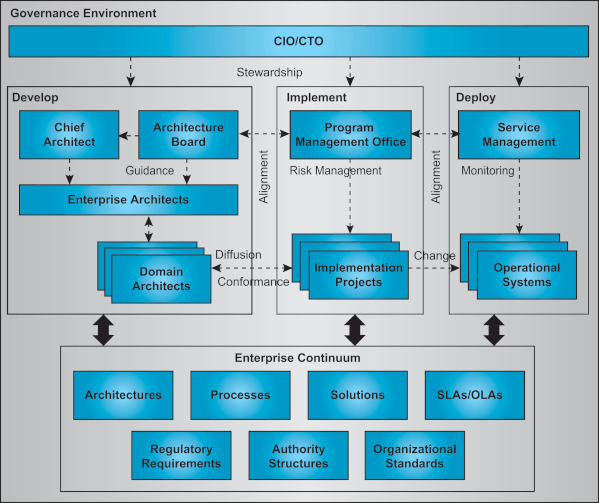Architecture Governance Framework – Organizational Structure
Overview
In the ever-evolving landscape of modern business, effective architecture governance is paramount to ensure that enterprise architectures and other architectural frameworks are managed and controlled efficiently. To achieve this, organizations must establish well-defined organizational structures that support governance activities. The Architecture Governance Framework provides a blueprint for these structures, fostering the alignment of IT strategies with broader organizational goals.
This article delves into the Architecture Governance Framework’s organizational structure, emphasizing its significance in guiding architecture governance practices within an organization.
The Key Elements of the Organizational Structure
A robust architecture governance structure typically comprises several key elements that synergize to ensure the effective management of architectural assets and processes. While the specifics may vary across different enterprises, the foundational components often include:
- Global Governance Board: At the apex of the architecture governance hierarchy is the Global Governance Board. This entity plays a pivotal role in shaping high-level architectural decisions, aligning them with the organization’s strategic objectives, and providing overarching guidance for architecture governance initiatives.
- Local Governance Board: Beneath the Global Governance Board, Local Governance Boards function at a more granular level. These boards focus on the specific architectural requirements and concerns within their respective domains or business units. Local Governance Boards tailor governance practices to suit their unique needs while ensuring alignment with the broader architectural framework.
- Design Authorities: Design authorities are responsible for overseeing the development and maintenance of architectural designs. They possess the expertise and knowledge required to assess architectural proposals, ensuring they adhere to established standards and align with strategic goals.
- Working Parties: Working parties consist of individuals or teams dedicated to specific architecture-related tasks or projects. They work collaboratively to implement and refine architectural solutions, ensuring that the designs conform to governance guidelines.
The illustration provided by the Architecture Governance Framework – Organizational Structure serves as a reference point for organizations looking to establish an effective architecture governance initiative. While the specifics may vary, these fundamental elements are broadly applicable and adaptable across a wide array of organizational types.

Key Areas of Architecture Governance
The Architecture Governance Framework identifies three key areas of architecture management: Develop, Implement, and Deploy. Each of these areas involves specific responsibilities, processes, and structures, with the Enterprise Continuum serving as a supportive backbone for all governance activities.
- Develop: The Develop stage primarily deals with the creation and refinement of architectural designs. It involves processes and structures that are often closely linked to the TOGAF Architecture Development Method (ADM) and its usage. During this phase, architectural blueprints and strategies are crafted, laying the groundwork for subsequent implementation.
- Implement: The Implement stage, typically associated with Phase G of the TOGAF ADM, focuses on the governance of architecture during its actual implementation. This phase ensures that architectural designs are translated into tangible solutions while adhering to governance principles and guidelines.
- Deploy: The Deploy phase extends governance beyond implementation and into the operational phase. It encompasses the ongoing management and optimization of implemented architectures, ensuring they continue to align with organizational objectives and adapt to changing needs.
Operational Benefits of Architecture Governance
Effective architecture governance, as exemplified by the Architecture Governance Framework – Organizational Structure, yields a multitude of operational benefits for organizations. These benefits extend across various facets of the business, including IT processes, resources, and information management:
- Alignment with Organizational Strategies: Architecture governance links IT processes, resources, and information to broader organizational strategies and objectives. It ensures that technology investments and initiatives are tightly aligned with the organization’s overarching goals, enhancing overall strategic coherence.
- Institutionalization of Best Practices: It integrates and institutionalizes IT best practices, fostering a culture of excellence within the organization. This, in turn, leads to greater efficiency and effectiveness in IT operations.
- Alignment with Industry Frameworks: Architecture governance aligns with industry frameworks such as COBIT, encompassing critical domains like planning and organizing, acquiring and implementing, delivering and supporting, and monitoring IT performance. This alignment enhances regulatory compliance and operational efficiency.
- Optimization of IT Assets: It enables organizations to maximize the utilization of their information, infrastructure, hardware, and software assets. By ensuring that these assets are leveraged to their fullest potential, architecture governance helps optimize resource utilization and reduce unnecessary costs.
- Asset Protection: Architecture governance plays a crucial role in protecting the underlying digital assets of the organization. It enforces security measures and accountability, mitigating the risks associated with data breaches and cyber threats.
- Support for Regulatory Compliance: It supports regulatory and best practice requirements, ensuring that the organization remains audit-ready at all times. This fosters a culture of responsibility and accountability, vital in today’s compliance-driven environment.
- Visible Risk Management: By providing a structured approach to governance, architecture governance promotes visible risk management. Potential risks are identified, assessed, and mitigated in a proactive manner, reducing the likelihood of disruptive incidents.
Conclusion
The TOGAF Architecture Governance Framework serves as a comprehensive approach encompassing processes, cultural orientation, and owned responsibilities. It ensures the integrity and effectiveness of an organization’s architectures throughout their lifecycle. By implementing the organizational structure and principles outlined in the framework, enterprises can harness the operational benefits of architecture governance, positioning themselves for sustained success in an ever-evolving digital landscape.

